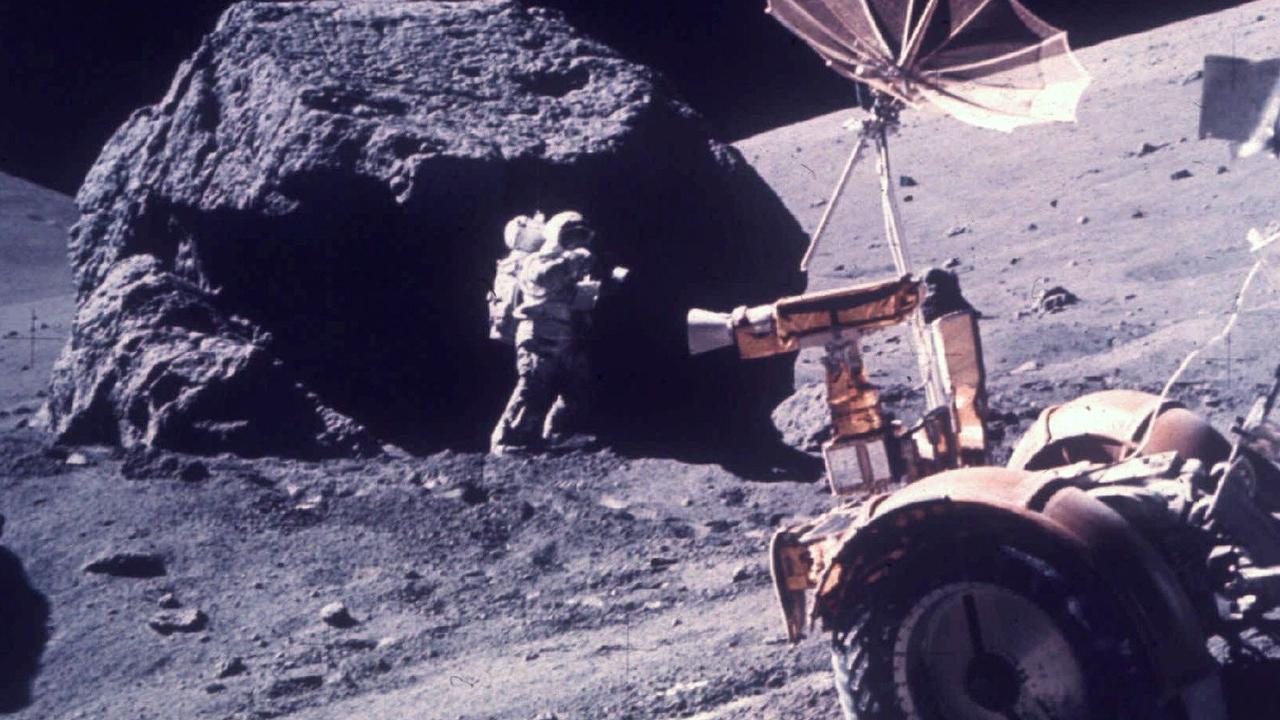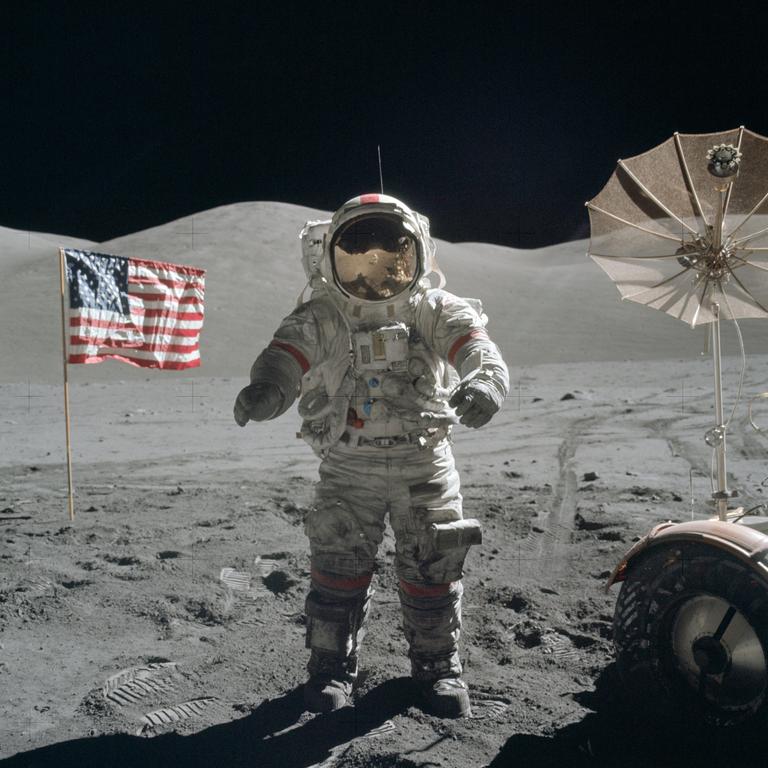Rocks collected by Apollo 17 astronauts in 1972 reveal age of the moon
US astronauts collected 110kg of moon soil and rock samples 51 years ago and brought them back to Earth on Apollo 17. New technology has used those rocks to reveal the age of the moon

READING LEVEL: RED
During the Apollo 17 space mission in 1972 — the last time people walked on the moon — US astronauts Harrison Schmitt and Eugene Cernan collected 110kg of soil and rock samples that were returned to Earth for further study.
A half-century later, zircon* crystals inside one of the magma* rock fragments collected by Dr Schmitt, who is also a geologist*, are giving researchers a deeper understanding about how the moon was created and its age.

Until now, the exact timing of the moon’s formation has been hard to pin down but scientists this week said a process called atom probe tomography*, which can study atoms inside the zircon crystals, proved our moon is about 40 million years older than previously thought — forming more than 4.46 billion years ago.
The leading theory about the birth of the moon is that during the solar system’s chaotic* early history a Mars-sized object called Theia slammed into Earth.
This blasted magma, also called molten* rock, into space, forming a disc* of debris* that orbited* Earth before forming into the moon.

Cosmochemist* Philipp Heck, senior director of research at the Field Museum in Chicago and senior author of the study published in the journal Geochemical Perspectives Letters, said the zircon crystals — the first solids to form after the moon’s magma ocean cooled — are excellent geological* timekeepers
“I love the fact that this study was done on a sample that was collected and brought to Earth 51 years ago. At that time, atom probe tomography wasn’t developed yet and scientists wouldn’t have imagined the types of analyses we do today,” he said.
“Interestingly, all the oldest minerals found on Earth, Mars and the moon are zircon crystals,” UCLA planetary scientist and study co-author Bidong Zhang said.

The moon rock was collected by the Apollo 17 astronauts in the Taurus-Littrow Valley at the southeastern edge of the moon’s Sea of Serenity* and stored at NASA’s Johnson Space Centre in Houston, Texas.
Prof Heck said the moon, which orbits Earth at an average distance of about 385,000km, made life on our planet possible.
“The giant impact that formed the moon was a cataclysmic* event for Earth and changed Earth’s rotational speed*. After that, the moon had an effect on stabilising Earth’s rotational axis* and slowing down Earth’s rotational speed,” Prof Heck said.
“The formation date of the moon is important as only after that, Earth became a habitable* planet.”

Prof Zhang agreed. “The moon helps stabilise Earth’s axis for a stable climate. The moon’s gravitational* pulls help shape the ocean’s ecosystem*. The moon is inspirational to human cultures and explorations. And NASA and other space agencies see the moon as a stepping stone for future deep-space explorations,” he said.
POLL
GLOSSARY
zircon: a mineral that forms in rocks
magma: hot liquid rock located deep below the Earth’s surface
geologist: a scientist who studies the solid, liquid, and gaseous matter that make up the Earth and other planets
atom probe tomography: three-dimensional technique to study the structure of materials at an atomic level
chaotic: hard to predict
molten: turned into liquid by heat
disc: flat, thin, circular object (like a frisbee)
debris: scattered leftover pieces of something
orbited: move in a circle
cosmochemist: someone who studies the chemical composition of and changes in the universe
geological: relating to the study of the earth’s physical structure and substance
Sea of Serenity: a dark lava crater on the moon
cataclysmic: causing sudden and violent disruption
rotational speed: the speed at which an object rotates or revolves
axis: an imaginary line about which something rotates
habitable: able to be lived in
gravitational: relating to movement towards a centre of gravity
ecosystem: a community or group of living organisms that live in and interact with each other in a specific environment
EXTRA READING
NASA on mission to mysterious metal asteroid
Question mark spotted hanging in space
NASA prepares to return to the moon
QUICK QUIZ
How have scientists gained a greater understanding of how the moon was formed?
What is the theory behind how the moon was created?
How many years ago were the rocks collected and from where on the moon?
What helps shape the ocean’s ecosystem?
What are the oldest minerals found on Earth, Mars and the moon?
LISTEN TO THIS STORY
CLASSROOM ACTIVITIES
1. Diagram of the moon
Draw a detailed diagram of how the moon was formed and how this in turn made Earth habitable for humans.
Your diagram should involve sketches, labels and the process of how this all came about using the information from the article.
Time: allow 25 minutes to complete this activity
Curriculum Links: English, Science, Critical and creative thinking.
2. Extension
Atom Probe Tomography is the latest scientific technology to find out such things, like the age of the moon. What might the new technology over the next 50 years be able to tell us about space?
Do you think we’ll ever be able to live on another planet? Explain your answer.
Time: allow 15 minutes to complete this activity
Curriculum Links: English, Science, Personal and social, Critical and creative thinking.
VCOP ACTIVITY
1. Sum it up
After reading the article, use your comprehension skills to summarise in a maximum of three sentences what the article is about.
Think about:
— What is the main topic or idea?
— What is an important or interesting fact?
— Who was involved (people or places)?
Use your VCOP skills to re-read your summary to make sure it is clear, specific and well punctuated.

